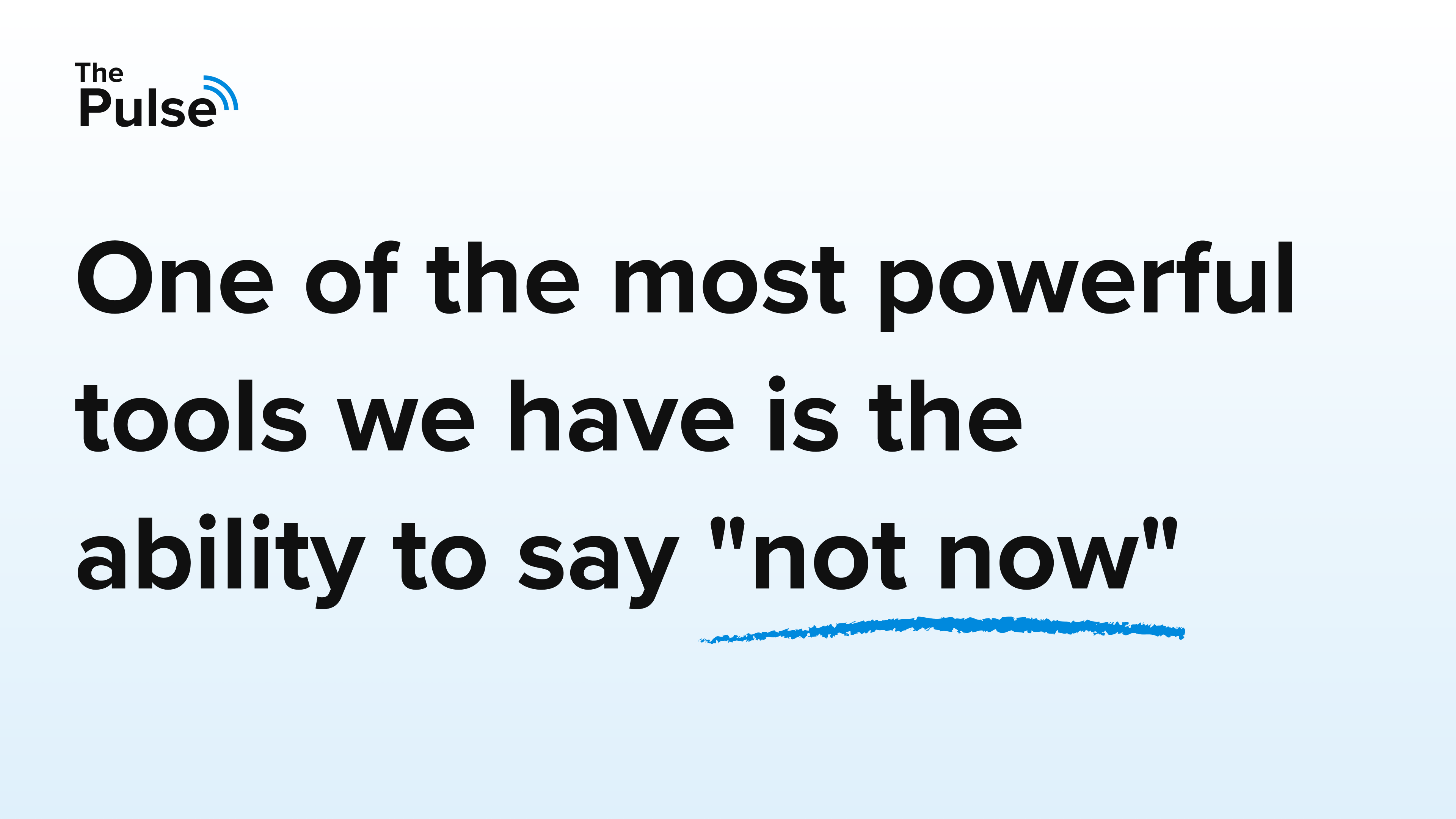
In the last edition I wrote on how Strategic Planning plays a crucial role in shaping the culture of an organization. And the feedback was pretty astounding.
For many, it was the first time they had really thought of the two as connected.
Many of the responses were oriented around ways to ensure you're positively impacting culture, or at the very least, how to avoid negatively impacting it. So I thought we could address both…
I wanted to start by focusing on a topic to help positively impact culture and press into an area I myself have struggled with in past roles and at Elate: Ruthless Prioritization.
As a co-founder and CEO, one of the most challenging areas of my role is turning away what I think could be a good idea.
Frankly, it’s not just in this role that I’ve struggled with saying "no" to ideas; in past roles I’ve also been forced to flex this area of my professional development in order to maximize my abilities as a Strategy and Operations Leader.
While there are several reasons as to why I’ve struggled with ruthless prioritization, the two major areas I’ve identified are:
- a fear that saying "no" will thwart innovation
- adversely impacting employee engagement throughout the business
I’ve always wanted team members to not only understand where we are going as a company, but more importantly, feel as though they are part of building something special.
Early in my career, I made the mistake of thinking that this came by way of freedom and flexibility to take on projects that people were passionate about. Ideas or initiatives that they were willing to go the extra mile to bring to life.
While we certainly want team members engaged, the truth is that oftentimes they are defining their work and projects without the complete picture. Heck, for many, they get nothing more than a set of company values, a company kickoff presentation, or a goal that's set in a vacuum with their manager (more on this one below).
Further, this behavior at the individual contributor level is reinforced by the fact that Leadership goes through a similar practice.
Time and time again we see companies set too many objectives, or worse, objectives that are simply aligned to what that Leader thinks the rest of Leadership wants to hear. Some that come to mind include overly aggressive sales goals that have no realistic chance of being met, or product commitments that would require an engineering team twice the size you have today.
Sound familiar?
These goals get set in an overly audacious way because there is a lack of accountability, and many Leaders have been trained to treat Strategic Planning as a game to be played.
If you say you can commit ‘x’, then you will be given ‘y’ resources. And if it doesn’t happen, then, is there really any level of accountability? As the saying goes, "shit rolls down hill", right? 💩
That’s why it’s so important that we set the tone for ruthless prioritization. Especially this year more than any other in the past decade.
We have to be willing to stack rank objectives, prioritize based on value and effort and what can and should be taken on by the company.

If we’ve learned anything from the past year, it’s that we can’t just live in a world where we say "yes" to everything. Resources are finite, budgets are real, and companies need to be built for sustainability and growth in a healthy way.
But it starts at the top. ⬆️ Without Leadership prioritization, your company won’t be able to prioritize.
However, just because you place an emphasis on prioritizing the right work, doesn’t mean that every conversation has to end in "yes" or "no".
One of the most powerful tools we have is the ability to say "not now".
In a world where everything seems to be a competition with a winner and loser, we don’t have to take on that sentiment in Strategic Planning. Sometimes we can have great ideas, or ones with intriguing potential.
However, it just might not be the right time.
This is where the organization’s ability to clearly articulate the long-term vision and successful outcomes of annual themes is imperative.
If we can point back to where we are going and why we are prioritizing certain objectives over others, then it also provides us the opportunity to also say, "Hey, that’s a great idea. I love where it could potentially take us. That said, I think it’s something for us to revisit in Q2, because of what we’ve all aligned on already."
While ruthless prioritization might feel like an exercise of simply saying "no", the truth is that by focusing on what really matters to the company, you are actually providing your employees with the ability to discern how they should spend their time and efforts.
You provide autonomy through clarity, rather than confusion through chaos.
As we like to say at Elate, if everything is a priority, then nothing is a priority.
PS - I dove into ruthless prioritization in the first edition of the Pulse.
Is Strat Planning Hurting Your Culture?
Ruthless prioritization is an area of focus to help ensure your planning process isn’t hurting your culture. But how do you know if what you’re doing today is having a negative impact?
While there can be a number of factors that play a role in this connection, these are three symptoms we commonly see when working with companies:
- You’re isolating strategic planning to just leadership (and maybe VPs),
- You’re more concerned about the intricacies of the planning process rather than the outcomes themselves, or
- You’re lacking a consistent review process and top-down communication on progress…
If any of these can be self-diagnosed, then it might be worth reevaluating the current process in place for your organization's planning.
This doesn’t mean you need to overhaul everything. It depends on the scope of your org’s situation.
But - it’s something you should be aware of, and if there are small windows of opportunity to fix the gaps, I would recommend doing so.
I dive into each of these in this article. Give it a read... would love your thoughts.
Performance Management tools: good for managing people, bad for managing strategy
("But hey, we can track goals!")
I’ll just come out and say it: a significant challenge that hampers companies in executing their strategy is the use of tools that were not specifically designed for Strategy and Operations Leaders - notably Performance Management tools.
Now, let’s be clear… Performance management tools play a vital role for People/HR teams... but there's a noticeable gap when you attempt to use them for building, executing, and reviewing your company's strategy.
Here's why:
- Employees set goals in isolation, disconnected from the company’s overall strategy (that often lives elsewhere).
- Employees struggle to prioritize their efforts due to a lack of understanding about the company’s direction.
- Goals are typically reviewed once a quarter, at best.
- Leadership often lacks visibility into employee goals.
- The Operating Plan crafted by leadership is disconnected from the work being carried out across the org.
If you are building your strategy in a spreadsheet that's inaccessible to the organization while also asking employees to track individual goals using Performance Management tools, you should expect 1) misalignment, 2) accountability issues, and 3) a disconnect between priorities and organizational work.
That's all for today. Hope you're having a great week.
-Brooks


